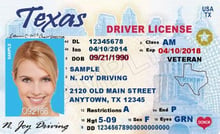

All your missed questions are saved
automatically for extra practice.




It's a practice test that's automatically made up of all your missed questions. Once you finish this test, you’ll be able to revisit your Challenge Bank™ to practice and sharpen your skills.
View All PlansAdding difficult questions to Challenge Bank™ is an exclusive Premium feature. Unlock access to 650+ exam-like questions, a Pass Guarantee, personalized study plans, and more.
View All PlansFree DMV Permit Practice Test – Texas 2025
| 90-100 | => | 9% |
| 80-89 | => | 18% |
| 70-79 | => | 28% |
| 60-69 | => | 25% |
| <60% | => | 21% |
Texas requires a vision screening and the passing of the official knowledge (permit) test before issuing a learner’s permit. The learner permit test consists of 30 multiple-choice questions covering traffic laws, road signs, safe driving practices, alcohol and drug impact on driving ability, and distracted driving. To pass, you must answer at least 21 questions (70%) correctly. Though online testing options are available for adults through certified courses, teens must complete the permit test in person. If you fail the test, you may retake the exam next business day. This free online Texas DMV permit practice test is updated for December 2025 and designed to help you pass the first time by providing questions and answers based on the 2025 Driver Handbook.


Accuracy & authorship
How to use this practice test
- Start here. One of 4 free Texas tests. ~6 min. Read explanations as you go.
- Cover more ground. All tests have different questions - no repeats.
- Finish strong. Try the Exam Simulator for a full-length run.
Why this works
- Exam-like questions from the current handbook + real test-taker patterns. Explanations cite the manual.
- AI Assistant explains tricky items in plain language.
- Performance Insights show your weak topics and what to study next.
- Challenge Bank™ saves your mistakes for targeted practice.
Actual DMV permit test: What to expect?
- Where: Any Texas DMV office (find locations)
- Bring: ID + SSN + residency proof + permit/license fee (see checklist)
- If you fail: Retake the next business day.
- Commonly missed: passing and lane marking rules, legal blood alcohol limits and DUI rules.
- Ready to schedule? Book your TX DMV appointment
Real Texas drivers who passed first try
Verified student reviews • Shared with permission

About the Texas learner permit
Texas operates a Graduated Driver License (GDL) Program for aspiring drivers under 18: a two-phase system that introduces driving privileges gradually and includes the learner’s permit and the provisional license. You must hold each for a specific length of time and fulfill certain requirements before moving to the next. The state’s GDL program ends when you turn 18, when the restrictions of the GDL program are lifted, and you are eligible for a standard driver’s license (assuming you’ve met all other requirements).
Once prepared, you will need to submit a Verification of Enrollment and Attendance (VOE) form (if you’re under 18) as proof of school attendance and progress, proof of identity (passport or birth certificate), proof of your Social Security number, two proofs of Texas residency, completion certificate from a driver education course (DE-964 form) if you’re under 25, and the application for a driver’s license (DL-14A). Go to the DMV with your documents, pay the fee, and take the knowledge test. With urban centers like Houston and Dallas, rural highways, desert areas in the west, and coastal regions along the Gulf of Mexico, drivers must adapt to diverse conditions. Our website, in conjunction with the state’s Driver Handbook, will help prepare you for these conditions and ensure you pass on your first attempt. Check out our other free practice tests!
More TX DMV written exam resources
Are you in another state?
- Alabama
- Alaska
- Arizona
- Arkansas
- California
- Colorado
- Connecticut
- Delaware
- District of Columbia
- Florida
- Georgia
- Hawaii
- Idaho
- Illinois
- Indiana
- Iowa
- Kansas
- Kentucky
- Louisiana
- Maine
- Maryland
- Massachusetts
- Michigan
- Minnesota
- Mississippi
- Missouri
- Montana
- Nebraska
- Nevada
- New Hampshire
- New Jersey
- New Mexico
- New York
- North Carolina
- North Dakota
- Ohio
- Oklahoma
- Oregon
- Pennsylvania
- Rhode Island
- South Carolina
- South Dakota
- Tennessee
- Texas
- Utah
- Vermont
- Virginia
- Washington
- West Virginia
- Wisconsin
- Wyoming
We know what it takes to pass. And we’ve got the proof.
Driver’s Ed is - nobody wants to set foot inside the DMV. That’s why millions of learners trust us for simple, visual, effective prep.
An official & trusted partner in driver education
We are an officially recognized FMCSA Entry-Level Driver Training provider and a proud partner to over 2,500 libraries. We work with safety organizations like GHSA and the National Safety Council to help create safer roads for everyone.






A smarter way to study
Challenge Bank™
Our trademarked system automatically saves questions you miss, creating personalized tests that target your weak spots until you’ve mastered the material.
AI-powered feedback
Get smarter as you study. Our new AI-powered feedback provides detailed, question-level insights to help you understand the why behind each answer.
Interactive handbook
Go beyond the boring black-and-white manual. Our interactive handbook lets you read, listen with an MP3 audio version, or even chat with it to find the information you need, faster.
We build our practice questions from the current 2025 TX Driver Handbook and refine them using patterns recent test‑takers report.
Driver handbook • Knowledge‑test/permit overview • Fees & ID requirements • Office/appointment info
We mirror recurring themes (e.g., right‑of‑way traps, sign look‑alikes) and use similar distractors and wording styles.
We don’t collect or publish actual test items and we’re not affiliated with DMV.

